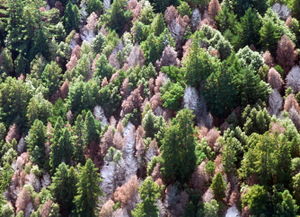Sudden Oak Death (SOD)

Sudden Oak Death (SOD) is a tree disease caused by the plant pathogen(Phytophthora ramorum). In addition to SOD, Phytophthora ramorum also causes Ramorum Blight. Phytophthora ramorum was first documented in Central California in the mid-1990s, and has since caused severe mortality of several oak tree species and most notably tanbark oak (Notholithocarpus densiflorus). In 2014, Phytophthora ramorum is estimated to extend from Santa Barbara in California to Curry County in Oregon [1].
Phytophthora ramorum thrives in cool, wet climates [2]. This disease got its name after affecting oaks and tanoaks suddenly and simultaneously in multiple coastal locations in California in the early 1990s [3].
Several tree species in California and Oregon forests have been infected with the pathogen. It is known to cause mortality in coast live oak, California black oak, Shreve oak, and canyon live oak, as well as tanoak trees. It causes twig and foliar diseases in other species such as California Bay laurel, Douglas-fir, and coast redwood. Implications of SOD spread include loss of habitat, loss of food sources for wildlife, increase in exposed soils, and changes in the frequency and intensity of wildfires.
References
- ↑ Citation needed
- ↑ California Oak Mortality Task Force
- ↑ Garbelotto M. and Hayden KJ. 2012. Sudden Oak Death: Interactions of the Exotic Oomycete Phytophthora ramorum with Naïve North American Hosts. Eukaryotic Cell: 11(11):1313.
Links
Disclaimer
This page may contain student work completed as part of assigned coursework. It may not be accurate. It does not necessary reflect the opinion or policy of [CSUMB], its staff, or students.